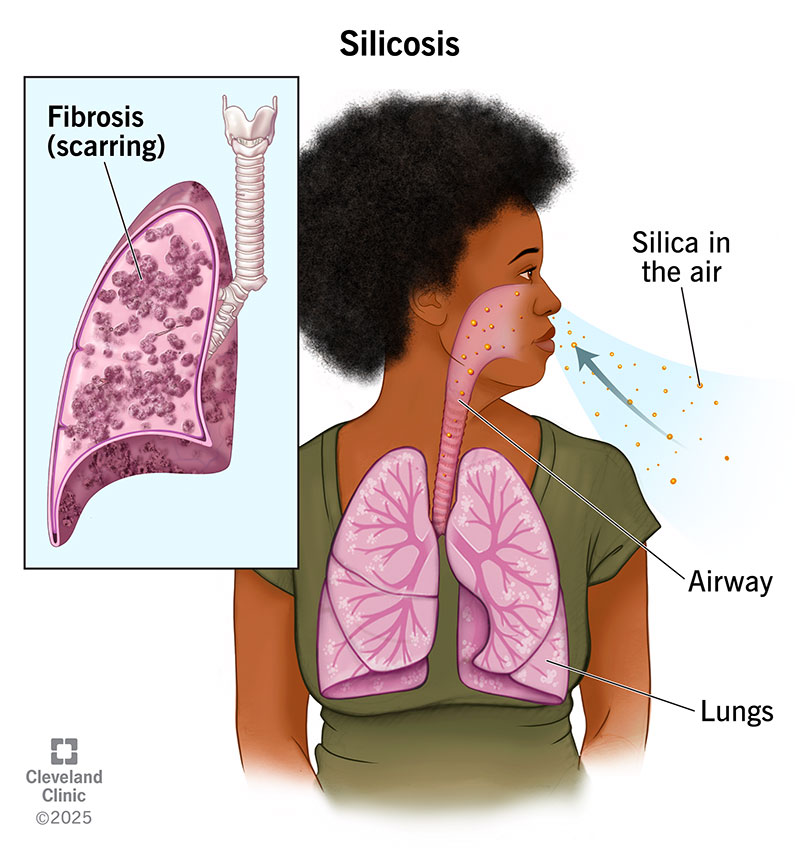Silicosis is a lung disease that can develop from breathing in silica dust, usually around mining and construction sites. Symptoms include a long-lasting cough, problems breathing, inflammation in your airways and scarring in your lung tissue. There’s no cure. But there are ways to manage your symptoms.
Advertisement
Cleveland Clinic is a non-profit academic medical center. Advertising on our site helps support our mission. We do not endorse non-Cleveland Clinic products or services. Policy

Silicosis (sil-eh-KOH-sis) is a type of interstitial lung disease that can occur from breathing in very tiny silicon dioxide particles (silica dust). Silica is a natural compound that’s in things like:
Advertisement
Cleveland Clinic is a non-profit academic medical center. Advertising on our site helps support our mission. We do not endorse non-Cleveland Clinic products or services. Policy
Manufacturers often include silicon dioxide (silica gel) packets in packages to absorb moisture.
Silica is nontoxic if you drink it or eat it. But inhaling certain kinds of silica dust can cause problems with your respiratory system. It damages the immune cells in the tiny air sacs in your lungs (alveolar macrophages). Alveolar macrophages (al-VEE-uh-ler MAK-ruh-feyj-es) are part of your immune system — they’re part of your respiratory system’s core line of defense.
Most people get silicosis because they breathe in silica dust at their jobs. Symptoms aren’t usually noticeable right away. But over time, silica can damage your lungs. For some kinds of silica, this can take about 10 years of regular exposure. With higher levels of exposure, lung damage can happen faster. Silicosis rates have improved with safety regulations. But in the past five years, a large number of people have developed silicosis from working with engineered stone products.
You can’t cure or reverse silicosis. But healthcare providers can help you manage symptoms. Severe cases can affect your ability to do daily activities. It can also be fatal.
Advertisement
Silicosis may develop in three ways:
The main silicosis symptoms include:
These symptoms can also cause:
Damage to your lungs from breathing in silica dust causes silicosis. This usually happens in a work-related setting.
Silicosis is a work-related lung disease. You’re at greater risk of developing silicosis if you work in the following industries:
People who have silicosis are at an increased risk of the following:
A healthcare provider will:
They may also ask about your job history. If they suspect silicosis or another lung condition, they’ll recommend additional testing.
Healthcare providers may recommend the following tests to help diagnose silicosis:
Advertisement
No. There’s no cure for silicosis. Healthcare providers can’t reverse lung damage from silica dust. They can only help manage your symptoms.
You can’t treat silicosis. But you can help manage your symptoms by:
In severe cases, healthcare providers may recommend a lung transplant.
Yes, there are ongoing clinical trials for silicosis treatments. Researchers use antifibrotic drugs to treat some forms of silicosis. Some of these drugs are experimental. But one drug — nintedanib (OFEV®) — has approval from the U.S. Food and Drug Administration (FDA) to treat pulmonary fibrosis.
If your healthcare providers think you’re a good candidate, they may suggest that you participate.
You should have regular checkups with a healthcare provider if you work around silica dust. Schedule an appointment right away if you have a cough or trouble breathing.
Call a provider right away if you have silicosis and notice new symptoms that concern you.
During your appointment, you may wish to ask your provider:
Advertisement
Your outlook depends on many factors, including:
Your healthcare providers will give you a better idea of what to expect, according to your situation. But in general, your outlook is better if your symptoms don’t get worse.
If silicosis causes progressive massive fibrosis, your outlook is poor. You’re more likely to have permanent breathing problems and a reduced quality of life. It’s also more likely to cause premature death.
It depends on the severity of your condition, your age and your overall health. Some people can live 10-20 years or longer after receiving a silicosis diagnosis. Your healthcare provider will give you a better idea of what to expect.
Yes, you can prevent silicosis. If you work around respirable crystalline silica dust, you can help lower your risk of developing silicosis by:
Advertisement
It’s also a good idea to get regular silicosis screenings through your employer. Screenings are tests that check for signs of silicosis before you have symptoms. Early detection is key to preventing severe symptoms.
No, silicosis isn’t cancer. It doesn’t cause your cells to grow out of control. But silicosis may be a factor in developing lung cancer.
Exercise may be helpful if you have silicosis. Discuss your exercise plans with a healthcare provider. They may suggest pulmonary rehab, which includes exercises that can help improve your breathing.
It’s common to write off a cough and other symptoms of silicosis as a common respiratory infection. But if you work around silica and have symptoms, it’s a good idea to schedule an appointment with a healthcare provider to figure out exactly what’s going on with your respiratory system.
There’s no cure for silicosis. Some cases are mild while others are very serious. Only a provider can tell you what to expect in your specific situation. They’ll work with you to create a plan to manage your symptoms and protect your airways from further damage.
Breathing issues can affect your life in many ways. Cleveland Clinic’s respiratory therapy program treats your symptoms so you can feel better day to day.

Last reviewed on 09/05/2025.
Learn more about the Health Library and our editorial process.